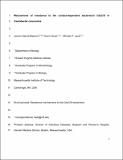Mechanisms of Resistance to the Contact-Dependent Bacteriocin CdzC/D inCaulobacter crescentus
Author(s)
García-Bayona, Leonor; Gozzi, Kevin; Laub, Michael T
DownloadAccepted version (9.939Mb)
Open Access Policy
Open Access Policy
Creative Commons Attribution-Noncommercial-Share Alike
Terms of use
Metadata
Show full item recordAbstract
The Cdz bacteriocin system allows the aquatic oligotrophic bacterium Caulobacter crescentus to kill closely related species in a contact-dependent manner. The toxin, which aggregates on the surfaces of producer cells, is composed of two small hydrophobic proteins, CdzC and CdzD, each bearing an extended glycine-zipper motif, that together induce inner membrane depolarization and kill target cells. To further characterize the mechanism of Cdz delivery and toxicity, we screened for mutations that render a target strain resistant to Cdz-mediated killing. These mutations mapped to four loci, including a TonB-dependent receptor, a three-gene operon (named zerRAB for zipper envelope resistance), and perA (for pentapeptide envelope resistance). Mutations in the zerRAB locus led to its overproduction and to potential changes in cell envelope composition, which may diminish the susceptibility of cells to Cdz toxins. The perA gene is also required to maintain a normal cell envelope, but our screen identified mutations that confer resistance to Cdz toxins without substantially affecting the cell envelope functions of PerA. We demonstrate that PerA, which encodes a pentapeptide repeat protein predicted to form a quadrilateral β-helix, localizes primarily to the outer membrane of cells, where it may serve as a receptor for the Cdz toxins. Collectively, these results provide new insights into the function and mechanisms of an atypical, contact-dependent bacteriocin system. IMPORTANCE Bacteriocins are commonly used by bacteria to kill neighboring cells that compete for resources. Although most bacteriocins are secreted, the aquatic, oligotrophic bacterium Caulobacter crescentus produces a two-peptide bacteriocin, CdzC/D, that remains attached to the outer membranes of cells, enabling contact-dependent killing of cells lacking the immunity protein CdzI. The receptor for CdzC/D has not previously been reported. Here, we describe a genetic screen for mutations that confer resistance to CdzC/D. One locus identified, perA, encodes a pentapeptide repeat protein that resides in the outer membrane of target cells, where it may act as the direct receptor for CdzC/D. Collectively, our results provide new insight into bacteriocin function and diversity.
Date issued
2019-01Department
Massachusetts Institute of Technology. Department of BiologyJournal
Journal of Bacteriology
Publisher
American Society for Microbiology
Citation
García-Bayona, Leonor et al. "Mechanisms of Resistance to the Contact-Dependent Bacteriocin CdzC/D in Caulobacter crescentus." Journal of Bacteriology 201, 8 (January 2019): e00538-18 © 2019 American Society for Microbiology
Version: Author's final manuscript
ISSN
0021-9193
1098-5530